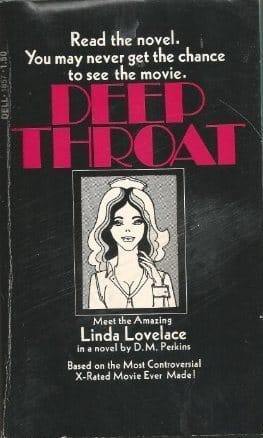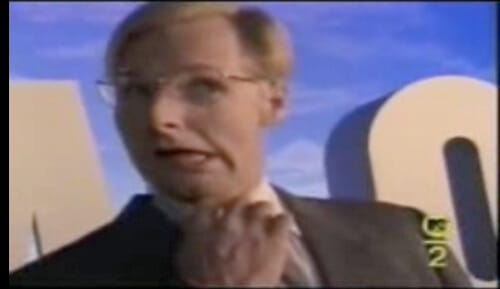Hollywood & Spine Archive: A Real Mouthful
An overview of the novelization to DEEP THROAT, originally published in May 2021.

Listen, so much novelization analysis is basically reading extended versions of popular sci-fi, fantasy and horror blockbusters. Even nerds gotta blow off some steam every once in a while. I'm proud of not treating this one like a total joke (even though the film was like watching paint dry - maybe a novelization of Behind the Green Door would've hit different) and, as always, hope it makes people think as much as it entertains. (originally published 5/27/2021)

I guess we should get some warnings out of the way: the material covered herein is unquestionably not safe for work and should not be read by persons under 18.
Deep Throat by D.M. Perkins (based on the motion picture written and directed by Gerald Damiano) (Dell/Quicksilver, 1973)
The pitch: Well...(sits at keyboard for a minute)...this is a prose adaptation of Deep Throat, the 1972 pornographic film that kicked off a groundbreaking era of adult movies. As a porno with a plot (in a manner of speaking), star Linda Lovelace displayed a unique talent that had the public's eyes a-poppin' and the moral fabric of Hollywood rent asunder - or something like that.
The author: It probably won't surprise you to know how little is known about the author. The name D.M. Perkins also appears on a trilogy of erotic books called Jennifer, published some 30 years after Deep Throat was released. Most reference databases indicate they are one and the same.

The foreplay: The mind reels at reading an adaptation of Deep Throat. When I discovered its existence, I knew I had to take it on; consider it my own personal Meltdown May, the product of an exceptionally guilty ex-Catholic. Its mere existence is vaguely inconceivable: not for its subject matter (Harlequin romances and fan fiction certainly exist) but for its place in the annals of printed film adaptations.
In a time when you had to physically leave your house to watch adult films, preserving the sensation of seeing a movie like Deep Throat probably has some intrinsic value. (The copy at hand corroborates this: its first printing was April 1973, nearly a year after the film's release, and its fifth was January of 1974.) But still...uh, isn't the point of the picture to see it? Plenty of folks get their kicks through printed peccadillos, but surely the appeal of reading about what exactly happens in this movie feels a little like hearing someone describe it in the schoolyard: fine enough, but nothing like actual experience.
Also, with 50 years of hindsight, it's pretty fair to call Deep Throat a work of cultural significance than artistic ones. If this generation of porn walked so the next could run, Deep Throat is comparatively immobile. The behind-the-scenes controversies aside - Lovelace, real name Linda Boreman, accused ex-husband Chuck Traynor, who appeared alongside her in the film, of brutal violence and sexual assault during and after the production, and became an anti-porn crusader until her death in 2002 - Deep Throat is not a good movie. The flimsy plot device is pretty misogynistic: a woman can only achieve physical gratification because of a scientific oddity that (sigh) puts a certain feminine part around her esophagus. Once that's established, it's off to the races with some increasingly gimmicky sequences of copulation. (You won't look at Coca-Cola the same way again, I assure you.) To this viewer, the picture offered little aesthetic enjoyment, if you catch my drift (sorry, Mom), and the whole thing wraps up in a tight 61 minutes.
So how on earth did Perkins stretch this payload to a generous 180 pages? The answers nearly laugh in the face of reality, including a made-up meta-subplot, some deviously purplish blue prose, and a surprising undercurrent of sexual progression that almost says something kind of important about the way we do it, even today.

The deed: So once we've established the, uh, thrust of the movie, Linda is hired by the wacky Dr. Young (Harry Reems) as a physiologist, helping un-kink men's dysfunctions with this one weird trick. Ultimately, she meets one she feels compatible enough with and considers marriage (if only he can receive some particularly private surgery). "The end, and deep throat to you all." Sure.
The book goes in a slightly different direction. Sandwiched in between those lusty sequences on the page are even more out-there sensual encounters, including a troupe of circus performers and a philosophizing, non-monogamous human with a female lover and, um, multiple sets of sex organs. (You can understand how this didn't make the picture.)
Eventually, Linda and her roommate Helen (played in the film by "Dolly Sharp," a woman whose identity was only identified decades after the film's completion) travel to a sex clinic in St. Louis; Helen receives some unseen therapy to break her unfulfilling cycle of sleeping around, while Linda is tasked with helping a smooth-talking adult film producer, who decides to essentially make the events of the book (and, by extension, the movie) into an XXX feature of its own, with Linda as the star. (The title? No, not Deep Throat - that would be ridiculous! It's Something More.) In the book's tidy conclusion, she is pleased with the film's runaway success (art imitates life - don't forget, the book followed the movie by about a year), but really does yearn for something more, which she finds in the same sequence that ends the picture. (This book goes all in on marriage as an intimate problem solver, which...is a lot to unpack!)

The extra material extremely out-there stuff - it did feel like time was bending while reading it, that a book adaptation of a movie included its own on-page movie version. Yet it probably improves on the "porn with a plot" angle considerably. Linda and Helen have motivations beyond finding the next body to pleasure, and while they're not written with the greatest of care - the sexual revolution didn't exactly center women as well as it could've, let's be honest - an attempt is made to tell a story that's more than just honking and bonking.
But trust that there's honking and bonking! Perkins' prose seemed adamant to skirt some sort of obscenity by building every act of lust into a series of metaphors and florid prose. You've got "Hebrew Nationals," "love rods," "sweetmeats," "flowers" - every body part euphemism you could imagine, as if on a dare. It even gets into the real novelization nitty-gritty, at times: the characters' thoughts, feelings and reactions to getting extremely sucked and/or fucked. It's simultaneously parody and incredible '70s sexual sincerity.

And that's not all: while the story overall could imagine a woman's wishes better - indeed, an area of improvement for generations of adult material - there is a fascinating through line running across all of Linda's "patients." They all have unusual intimate desires that feel weird enough to seek medical attention to fix; but in most cases, Linda, beyond her ministrations, treats every kink with an amount of respect and an open mind. Again, consider the not-so-ideal realities behind this movie - it's amazing that it produced this message, regardless of intent.
The aftercare: Look, we've seen a lot of attitudes about "alternative" sexual practices and identities shift and change (hopefully in a positive direction, or at the very least better than before) in the times since adult films went from movie-house to VCR to streaming. Against all odds, it's worth thinking about how generations have understood thornier concepts quicker and spoke more honestly about wants and needs. I'm not sure those were the lessons taken from the "porno chic" movement - when it became hip for the Eberts and the Schickels of the world to wax informative about the pictures' artistic values - but if it's an accidental side-effect of reading an adaptation of an overrated work like Deep Throat, maybe that can't be all bad.
Besides, reading is sort of a solo act as it is - maybe the self-satisfaction is all that matters here.
